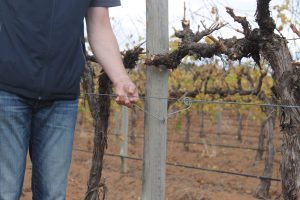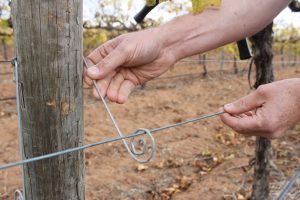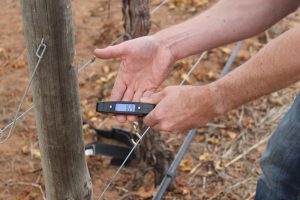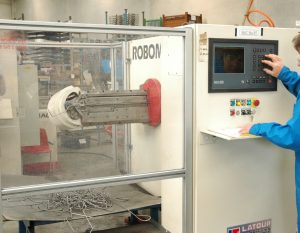How a new vineyard solution for stray foliage wires was created
Stray foliage wires can cause significant amounts of machinery downtime and production loss for vineyards. One enterprising grower took it upon himself to come up with a solution to this ever-present problem. The result is a new and innovative product that he hopes will change vineyard operations forever. Hans Mick talked to its inventor to find out the full story.
Langhorne Creek vineyard operator Gregg Colbert knew there had to be a better way of doing things.
With almost two decades of experience working vineyards in South Australia, the former Clare Valley grapegrower had a question on his mind.
“How can we lock the foliage wire to the post and make it just as simple to unlock” he explained.
“I spent many hours thinking while driving up and down vine rows, how can this system be better?
“I’ve never sat in the tractor and thought about nothing. [I’m] always thinking, always thinking about something. ‘How something can be better?’, ‘how can we make things better?’ But this is my first invention.”
And with his new invention, dubbed ‘Tidywire’, having already shown positive results in vineyard trials, Colbert explained why it was needed.
“After hitting numerous foliage wires myself – I’ve hit many, many a foliage wire over my 19 years – I’ve seen many recommendations: hooks, shanks, etc. But none of them have come to fruition or been effective.”
Having grown winegrapes around Clare in SA’s mid-north for eight years, Colbert said he understood the problem well.
“It’s a problem at the moment for vineyards because of the down time as well as the loss in machinery production outcomes.
“My trials investigated lost time during mid row machinery operations due to stray foliage wires in the vine mid rows.
“I’ve found slasher operators were spending ten to 15 minutes per hour moving and shifting foliage wires out of the way.
Colbert said operators are hitting a stray foliage wire once per day across an average two to three week period. He said this can result in lost production, labour and travel time to remove tangled wire safely from machinery, before slashing operations can resume.
Then there’s the issue of damage to equipment.
“The long-term effect on machinery is far less when you haven’t got wires tangled in your seals, in your gear boxes,” he reasoned.
He said the cost of re-entry into the vine row later to repair and replace the broken wire was another factor to consider.
“All of these costs can exceed up to $270 each time a foliage wire is struck and tangled.
“The cost can be in excess of $100 just for each machinery operator to shift or move foliage wires out of harm’s way each day.
“These are all costs that accumulate each year, especially during winter and spring months while foliage wires are down.
“This is all wasted money and time that can be spent elsewhere in more important areas.
“I’ve grown grapes myself and I know how tight money can be. Why spend money in areas where they can be fixed so easily?” he asked.

Spiral locking mechanism
After giving the problem time to sink in, Colbert went about coming up with a solution and, eventually, Tidywire was born.
In a basic sense, the device’s core concept is its spiral locking mechanism. Colbert said that once the foliage wire is engaged during hand clean up and pruning, it can’t remove itself upwards, sideways or downwards during harvest or any other time.
“Basically it’s made up three components, the loop at the top to secure it to the post, the length of the shank and the spiral mechanism at the bottom,” he explained.
“The spiral mechanism is the nuts and bolts of the device – that’s what doesn’t allow the foliage wire to escape.
“Unlike other methods Tidywire keeps the foliage wire off the ground and secure to your trellis at all times.
“It’s very easy to engage the foliage wire into Tidywire throughout the hand clean up and pruning process. It’s just as easy to disengage the foliage wire in late spring when the canopy requires lifting up.
“Contractors understand that concept very, very well.
“When the foliage wire is in its upright position, the Tidywire is sheltered for protection behind the mid row post. And when it comes time through hand clean up pruning, the foliage wire is engaged into the Tidywire out of harm’s way. There’s no way that it can become tangled, or can impede on any machinery.”
He said its visibility to machine operators can also improve production outcomes when it comes to cultivation, rotary hoeing, spraying herbicides and slashing.
Colbert said the device’s final design achieved all of his aims.
“My first initial prototype was far different than my final outcome. I knew that finally I had a device that worked the minute that it rolled off the production line.”
He said the design is a ‘step forward’ when compared to existing options for securing wires.
“The alternatives on the market at the moment are great for what they do, but for holding foliage wires through dormant and infant periods they just can’t hold the foliage wire to the trellis where my spiral will hold it in any conditions.”
The design was developed to be used regardless of vineyard contours, undulation or terracing beneath vines, or the bow of the vine trunk.
And Colbert said its durability was designed for use in any climate, including in colder regions.
“It can withstand any weather conditions; it’s basically a stronger material than your cordon wire.
“The actual steel gains strength over time. The carbon inside the steel actually solidifies the product more and more the longer that it’s out in the conditions.”
“[It’s] guaranteed to outlive the life of your wooden post while being 100% reusable in the event that the mid row post has to be replaced.”

Successful vineyard trials
To test its strength and usefulness in a real vineyard setting, Colbert said he has taken his invention out into the field for trials across a number of Langhorne Creek operations.
“I’ve found that 100 installed tidywires per hectare keeps both foliage wires on either side of the vine suspended off the ground and visible at all times for all machinery operating the mid rows.
“The biggest thing I’ve taken away [from the trials] is that it does work. In its final configuration it’s a product that can stand up, it’s a product that can withstand everything that’s thrown at it.
“The trials have [also] shown how much more can be achieved when you’re not stopping and starting all the time with your machinery operations. It’s really proven that you can achieve far more when you’re not grounded to a halt.
“It is worth noting that I was able to install Tidywire across one hectare in 45 minutes using a normal fencing staple to secure it to the wooden post.”
Colbert said now that trials have proven the design’s practical effectiveness, he hopes it may benefit the broader winegrape growing sector.
“That was my whole idea behind it; that was to share my idea with the industry. I know how much the industry embraces new ideas and this is my idea,” he said.
“Hopefully it will now go out into the big broad world of viticulture. I want to tap into all regions that cater for foliage wires.”
Workplace health and safety
Colbert said the device can also act to help reduce workplace health and safety risks associated with lifting wires, which can often lead to back strain for vineyard employees.
“I know that’s a big thing now as well and anything to reduce back strains does help. Tidywire acts as a good lifting aid when lifting wires in late spring and it makes an enormous amount of difference when you don’t have to pull the foliage wires out of the grass and out of the mud and dirt to lift,” he explained.
“Unlike other methods, there’s no need to carry extra tools to engage or disengage the foliage wire into Tidywire. There’s absolutely no need to walk that down the row at all during disengaging and engaging periods.”
Colbert is proud of the fact that his new product is wholly made in Australia, at a manufacturing plant operated in Adelaide by Multi Slide Industries, a former parts supplier to South Australia’s now defunct car industry.
“[It’s] manufactured from Australian made spring galvanised high tensile steel.
“I could have gone with a cheaper made steel from overseas, and be 25% cheaper, but I don’t want to impede on the quality. I’ve chosen to go Australian made, Australian manufactured […] I know that it makes it strong and durable.”
He said the strength and flexibility are core qualities of the device.
“It can withstand up to 25kgs of force before losing any shape or form in the spiral. I’ve measured out in the field a foliage wire in its holding capacity weighs upward of two kilograms.

“So it can pretty much withstand 13 times the weight that is required.
“The biggest challenge we found during manufacturing was the spiral had to be flat. I didn’t want the spiral to impede on gravity hiding the Tidywire behind the post when it’s not in use. I found a stronger strength steel but I couldn’t have a flat spiral and nor could I get it in galvanised so it would have just rusted overnight. I needed a product that could withstand the weather, could withstand the weight,” he explained.
The process of turning his concept into a commercial reality has led Colbert to take the steps required to protect his intellectual property, both in Australia and internationally.
“The patent application has been lodged because of the ease of which the device is to be emulated. I’ve protected all avenues […] I’ve registered the design, I’ve protected the idea and I’ve protected the shape.
“That was one of the lengthiest processes that I’ve been through for the whole situation and now I’m well on my way to getting the patent,” Colbert said.
Colbert said his innovation offers good value for growers, and should be seen as a medium-term investment that will provide longer-term financial benefits.
“At an introductory price of 80 cents [not including GST] my trial found it costs $80 per hectare to install.
“The price of the installation […] won’t be recouped in 12 months, but within two to three years it will be, because there would be no re-entry period, there would be far more tractor seat time, the wheels would keep turning whereas at the moment, the wheels are continuously stopping.”
But nothing can stop Colbert thinking about yet more ways to make improvements, including a steel post version of his product that he said is currently in development.
And he also has his eye on the bigger picture.
“I still believe there is an uncovered story in multi row equipment, for example slashing.
“One of the big things holding that back at the moment is stray foliage wires and stray trellis, whereas I believe,” he said with a laugh, “Tidywire can tidy your wire.”
More information can found online: www.tidywire.com.au/ or www.facebook.com/Tidywire-Enterprises-767221446815601/

This article was originally published in the Australian and New Zealand Grapegrower & Winemaker, June 2018 edition.


















